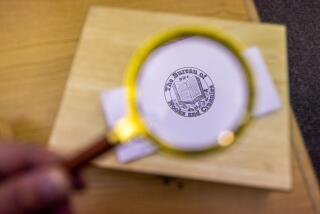Nixon Library Has More Than an 18 1/2-Minute Gap
“Dad, can we ride on Chou En-lai?”
Don’t even bother asking, kids. The life-size bronze likenesses of world leaders, like most other things at the Richard Nixon Library & Birthplace in Yorba Linda, have “Do Not Touch” signs. Too bad; the place really needs some tactile sensation to bring the 37th President to life for patrons--perhaps a “Wall of Stubble” made of black sandpaper that folks could rub their faces against to simulate the feel of Nixon’s round-the-clock 5 o’clock shadow.
I visited the Nixon library recently to view the “White House Style--Formal Gowns of the First Ladies” exhibit. Why not? It’s probably the most exciting exhibit that’s going to be there, given it’s unlikely they’ll install something more representative of the Nixon era, like a colorful diorama of the covert bombing of Cambodia.
The “White House Style” exhibit features reproductions of inaugural gowns and other finery of the First Ladies, from Martha Washington to Barbara Bush, with pit stops at Lucretia Garfield, Mary Todd Lincoln and other fashion-setters of the day. Rosalynn Carter’s gown reproduction is a blue and gold lacy thing that looks like it came straight off one of Elvis’ girls in “Harum Scarum,” and it’s easily the hippest thing in the display.
There’s some babble over this exhibit, suggesting that the First Ladies’ outfits actually were style-setters. Maybe at shops like Madge’s Big ‘n’ Wrinkled, but not with most designers on the Milan-to-New York circuit. The First Ladies haven’t exactly been on the cutting edge of fashion, perhaps in large part because, strictly from a guy perspective, there’s not a one of them except maybe the young Jackie Kennedy with whom you’d want to be stuck in a bomb shelter.
While maybe not so base, there is a certain “guy perspective” that permeates the exhibit. Looking down the hall at all the headless torsos on which these gowns are hung implies a pretty sorry statement about the limited role women have been accorded in American politics. Eleanor Roosevelt may have been able to push and achieve great things in her life, but most presidential wives have been relegated to the kitchen or garden, or were “goodwill ambassadors,” meaning their men allowed them to wave at foreigners.
I blame Richard Nixon for this--not that the attitude didn’t prevail for centuries before he was born. I just like blaming Richard Nixon, and his largely bookless library didn’t give me any reason to stop now.
I’m no great fan of snakes and weasels, but at least I learned to understand and respect them from visiting wild-animal parks. Would I could say the same for the Nixon library. Instead it just reminded me of many of the reasons why I actively loathed him in my youth.
The privately funded library understandably endeavors to present an upbeat vision of Nixon’s life and achievements. But it may not be possible to elevate a leader as fallen as he without stepping on the memory of others, either implicitly or overtly.
For an implicit example, an Oriental-themed gallery is devoted to his opening the door to China, which was certainly the major diplomatic achievement of his tenure. No mention is made, though, of how he’d helped slam that door himself more than a decade before, labeling Adlai Stevenson a pinko for even suggesting the world’s largest nation be allowed representation in the U.N.
Many of Nixon’s political advances were made not on his own record but on besmirching the records of others, calling them soft, or worse, on communism. Since the now-friendly Russian government recently averred that it has no record of Alger Hiss ever spying for it, maybe the library can alter its Hiss exhibit. After showing a young Nixon ruin Hiss’ life on national TV, a friendly jack-o’-lantern might pop open and say “Just kidding!”
Parts of the library--particularly the exhibits showing Nixon with his family--do help humanize the man a bit. There’s also a swell ‘40s Mercury woody wagon like one he once campaigned in. Then there’s a detailed recreation of the Lincoln Sitting Room, where the President liked to repair after a long day of betraying the public trust. Those into campy kitsch can watch the Checkers Speech on a vintage TV, or buy a $45 “Birthplace Birdhouse” in the gift shop.
But other parts of the library just tear open the wounds that festered during his presidency. Consider the section on Vietnam, which posits the President and his stalwart but very silent majority upholding the American way against all those opposed to the war, denigrated to in the library’s text as a “violent minority.”
As a friend of mine is prone to say, that really gets my hippie dander up. In retrospect I’m none too proud of the divisive “us versus the man” politics practiced by some in my generation at the time. But we weren’t the ones beating people bloody and senseless in the streets, or shooting our own children dead at Kent State. We weren’t the ones who campaigned “Bring Us Together” and then let future convicted criminal Spiro Agnew spew hateful invective at every dissenting party, who used the IRS to harass political rivals or who got future convicted criminal John Mitchell to employ the FBI, CIA and other agencies to spy, illegally wiretap, burgle and disrupt the legal democratic activities of American citizens in the peace, civil rights and even ecological movements.
We weren’t the ones who campaigned with a “secret plan to end the war” and then secretly and illegally extended the war into two other nations and dragged it on for needless years of additional death and sorrow before capitulating.
And then there was Watergate, where the President committed a crime, lied to the nation, threw every adviser he had to the wolves and then resigned rather than face certain impeachment, first gracing us with a smarmy self-pitying speech about how he was only stepping down for the good of the nation.
That would seem a little too much bloody earth for anyone to build a California tourist attraction out of, but the Nixon library doctors it with a mighty spin. Walk through the Watergate section’s dark lane of reflective black surfaces--shades of Washington’s Vietnam Memorial--and you could come out feeling sorry for the put-upon President, if you didn’t feel so manipulated instead.
I know people--the same who tune in Rush Limbaugh just to be outraged--who would doubtless gladly shell out the $4.95 admission again and again for the thrill of hating Nixon anew, but not me. That old civil war was fought over my family’s dinner table too many nights. I’d instead like to find the common humanity in those I once opposed, and, as you might gather by the tone of the writing above, the Nixon library doesn’t come close to helping with that.






